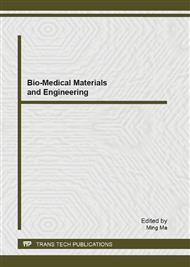p.322
p.328
p.333
p.338
p.344
p.350
p.354
p.359
p.362
Facile and Efficient Anti-Fouling Surface Construction on Poly(dimethylsiloxane) via Mussel-Inspired Chemistry
Abstract:
Poly (dimethylsiloxane) (PDMS) silicones have found many applications in biomedical devices, such as catheters and intraocular lenses. But their hydrophobicity makes the possibility of the unexpected bioadhesion. In this paper, we reported a facile and efficient anti-fouling surface modification method on PDMS via self-polymerization of dopamine and the followed hyaluronic acid immobilization. Dopamine, commonly used as a neurotransmitter, is also a small molecule mimic of the adhesive proteins of mussels. Self-polymerization of dopamine can produce a thin polydopamine (PDA) layer on PDMS surface. Subsequently, thiol group functionalized hyaluronic acid (denoted as HA-SH) was immobilized covalently onto the resultant surface by the coupling between thiol group and reactive polydopamine layer. Then, the in vitro adhesion behaviors of the lens epithelial cells (LECs) and macrophage were investigated for evalution the anti-fouling effect of the hyaluronic acid modified PDMS surface. The results indicated that the cellular adhesion on PDMS were greatly decreased after hyaluronic acid modification, which suggested the potential application of such hyaluronic acid modified PDMS in biomedical applications.
Info:
Periodical:
Pages:
344-349
Citation:
Online since:
August 2013
Authors:
Price:
Сopyright:
© 2013 Trans Tech Publications Ltd. All Rights Reserved
Share:
Citation:


